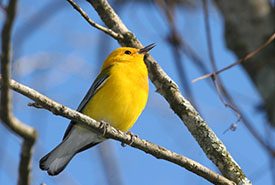Southern Norfolk Sand Plain Natural Area

Prothonotary warbler (Photo by Bill Hubick)
Norfolk County is a biodiversity hot spot and part of the Carolinian Life Zone. This unique ecosystem extends north from the Carolinas to southwestern Ontario.
In Ontario, the Carolinian Life Zone occurs south of a line running from southern Lake Huron to Toronto; it includes the entire north shore of Lake Erie.
Comprising less than one per cent of the country’s land mass, Carolinian Canada is home to 25 per cent of Canada’s population. It contains productive agricultural lands, forests and wetlands. The area provides habitat for nearly 25 per cent of our country’s species at risk, including:
- Acadian flycatcher
- American badger
- American chestnut
- eastern flowering dogwood
- eastern foxsnake
- prothonotary warbler
- spotted turtle
Habitat
Within this highly fragmented region, a large percentage of natural habitat has been converted for human use. But for generations, Norfolk County farmers and other rural landowners have cared for the county’s lands and waters.
The natural habitat in Norfolk County features:
• the highest percentage of forest cover in southwestern Ontario;
• long, connected ravines and floodplain systems;
• globally rare coastal dunes and beaches;
• internationally significant wetlands; and
• more than 45 provincially, nationally or globally rare plants and animals (one of the highest densities of rare and endangered wildlife in Canada).
For these reasons, the Nature Conservancy of Canada (NCC) has invested considerable resources in Norfolk County. It is a critical area for conserving the species and habitats unique to Canada’s Carolinian Life Zone, and for achieving conservation at a landscape level by building on a network of existing conservation lands.
Impact
NCC’s work in Norfolk has been generously supported by the Weston Family Foundation and other supporters. NCC has enlarged and connected existing natural areas at Long Point and Turkey Point, along Big Creek and in areas around Backus Woods, the St. Williams Conservation Reserve and South Walsingham Sand Ridges.
NCC also owns a patch of older-growth forest near Simcoe. This forest is named in honour of Norfolk’s esteemed naturalist, Monroe Landon.
These natural building blocks provide a rare opportunity to conserve some amazing examples of Carolinian species and habitats. Connecting the blocks through the restoration of open agricultural land is creating larger and more resilient blocks of natural habitat. This supports the rich diversity of species unique to this area.
Stewardship
Restoration
NCC is restoring open agricultural fields by reintroducing native plants characteristic of the Carolinian Life Zone. To date, 233 hectares (576 acres) have been restored. Restoration has also included rebuilding sand dune and sand barren features. This has created seasonal wetlands and swamp forest, and established early successional meadows and sand plain forest.
Biological inventories
NCC has conducted full biological inventories on 60 per cent of the lands it owns in Norfolk County. By documenting the plants and animals found on our properties, we can make informed land management decisions. This work is ongoing, ensuring all lands will be inventoried.
Invasive species management
NCC summer interns and stewardship staff continue to remove multiflora rose, autumn olive, garlic mustard and other non-native invasive species. This work is part of ongoing efforts to protect native plant communities.
Hunting
NCC recognizes the important role hunters play in maintaining the healthy balance of wildlife populations in settled landscapes. In the fall of 2011, NCC opened several Norfolk County properties to hunting through an application and permission letter system. Public response has been very positive.
For more information on NCC's work in Norfolk County, visit Southern Norfolk Sand Plain FAQs.
A priority for conservation
Please consider a gift to help protect and care for the Backus Woods Protected Area in the Southern Norfolk Sand Plain Natural Area.





